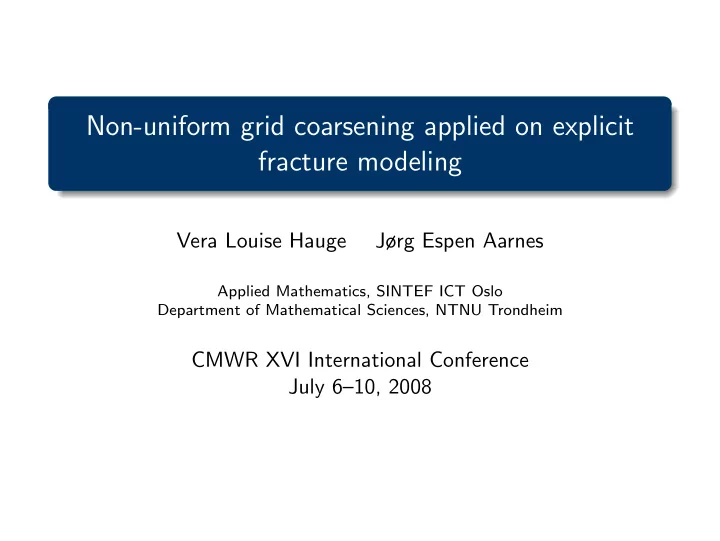

Non-uniform grid coarsening applied on explicit fracture modeling Vera Louise Hauge Jørg Espen Aarnes Applied Mathematics, SINTEF ICT Oslo Department of Mathematical Sciences, NTNU Trondheim CMWR XVI International Conference July 6–10, 2008
Non-uniform grid coarsening applied on explicit fracture modeling We want to determine a coarse grid suitable for saturation simulations that preserves important characteristics of the flow. Investigate two coarsening strategies: Non-uniform coarsening and Explicit fracture-matrix separation. Key ideas: Velocity computed on a fine grid which resolves the fractures Saturation computed on the coarse grid Homogeneous model with 100 fractures Heterogeneous model with 100 fractures CMWR 2008 2/ 13
Non-uniform coarsening algorithm Two parameters: V min : Minimum volume of a coarse block G max : Maximum flow through each coarse block The most important points from the algorithm: Group cells of similar flow magnitude into coarse blocks Coarse blocks have to be connected collections of fine cells Avoid too small blocks Avoid too large blocks CMWR 2008 3/ 13
Non-uniform coarsening algorithm Step 1: Segment log | v | into N level sets. Step 1: 118 blocks Step 2: Combine small blocks ( | B | < c ) with a neighbor. Merge B with less volume than V min with the neighbor that has velocity magnitude close to B . Step 2: 44 blocks CMWR 2008 4/ 13
Non-uniform coarsening algorithm Step 3: Refine blocks with too much flow | B | g ( B ) > G max . Step 3: 81 blocks Step 4: Combine small blocks with neighboring blocks. Repeat step 2. Step 4: 70 blocks CMWR 2008 5/ 13
Non-uniform coarsening algorithm log | v | on fine grid (2500 cells) log | v | on coarse grid (70 blocks) Advantages of the non-uniform coarsening algorithm: Applicable to both structured and unstructured grids Robust with respect to degree of coarsening Robust with respect to well-placement Aarnes, J.E. et al: 2007, “Coarsening of three-dimensional structured and unstructured grids for subsurface flow”. Adv. Water Resour: 30 (11), 2177-2193. CMWR 2008 6/ 13
Explicit Fracture-Matrix Separation (EFMS) 1 3 2 4 2 2 1 1 Step 1 Step 2 Step 3 Initial model: 100 × 100 grid cells, 50 fracture lines Step 1: Introduce an initial coarse grid, here 5 × 5 Step 2: Separate fracture and matrix part Step 3: Split non-connected blocks Disadvantage: Upscaling factor difficult to tune. CMWR 2008 7/ 13
Saturation equation and numerical discretization Water saturation equation for a water-oil system: φ∂ S ∂ t + ∇ · ( f w v ) = q w First-order finite volume method discretization Fluxes are computed as upstream fluxes with respect to the fine grid fluxes on the coarse interfaces CMWR 2008 8/ 13
Comparison of coarse grids: NUC, EFMS and Cartesian Heterogeneous model with 100 fractures. Saturations solutions at 0.48 PVI. NUC grid with 206 blocks EFMS grid with 236 blocks 20 × 20 Cartesian grid Fine grid CMWR 2008 9/ 13
Results of comparison Water−cut curves for heterogeneous model 1 0.8 0.6 # of blocks e(w) NUC 273 0.0273 0.4 Reference EFMS 294 0.1208 NUC Cartesian 330 0.1684 0.2 EFMS Cartesian 0 0 0.2 0.4 0.6 0.8 1 PVI NUC grid: consistently best accuracy. EFMS grid: reasonably accurate solutions for the homogeneous model. Coarse Cartesian grid: lower accuracy, smears out saturation profile. CMWR 2008 10/ 13
High and low permeable fractures Stochastically generated fractures: 20 low permeable and 100 high permeable fractures. K high perm frac > K matrix and K low perm frac ≪ K matrix . 25 simulations with different fracture distribution. Mean water−cut errors for homogeneous model Mean water−cut errors for heterogeneous model 0.2 0.25 EFMS EFMS NUC NUC 0.2 0.15 Mean error Mean error 0.15 0.1 0.1 0.05 0.05 0 0 36 : 38 20 : 24 9 : 11 40 : 47 19 : 21 6 : 9 Upscaling factors Upscaling factors CMWR 2008 11/ 13
Concluding remarks Accuracy: Both coarsening algorithms give more accurate results than conventional coarse grids. EFMS: poor accuracy when flow is influenced by underlying heterogeneous structures. Applicability: NUC: - Easy to tune upscaling factor. - Assumes no prior knowledge of fractures provided they are represented in the geomodel. EFMS: - Difficult to control upscaling factor. - Assumes “fracture cells” are prescribed. CMWR 2008 12/ 13
Thank you for your attention! Questions? http://www.sintef.no/GeoScale CMWR 2008 13/ 13
Recommend
More recommend